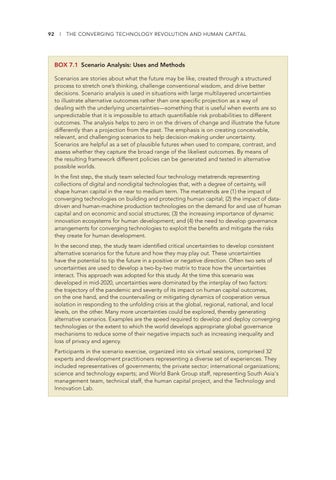92 l THE CONVERGING TECHNOLOGY REVOLUTION AND HUMAN CAPITAL
BOX 7.1 Scenario Analysis: Uses and Methods Scenarios are stories about what the future may be like, created through a structured process to stretch one’s thinking, challenge conventional wisdom, and drive better decisions. Scenario analysis is used in situations with large multilayered uncertainties to illustrate alternative outcomes rather than one specific projection as a way of dealing with the underlying uncertainties—something that is useful when events are so unpredictable that it is impossible to attach quantifiable risk probabilities to different outcomes. The analysis helps to zero in on the drivers of change and illustrate the future differently than a projection from the past. The emphasis is on creating conceivable, relevant, and challenging scenarios to help decision-making under uncertainty. Scenarios are helpful as a set of plausible futures when used to compare, contrast, and assess whether they capture the broad range of the likeliest outcomes. By means of the resulting framework different policies can be generated and tested in alternative possible worlds. In the first step, the study team selected four technology metatrends representing collections of digital and nondigital technologies that, with a degree of certainty, will shape human capital in the near to medium term. The metatrends are (1) the impact of converging technologies on building and protecting human capital; (2) the impact of datadriven and human-machine production technologies on the demand for and use of human capital and on economic and social structures; (3) the increasing importance of dynamic innovation ecosystems for human development; and (4) the need to develop governance arrangements for converging technologies to exploit the benefits and mitigate the risks they create for human development. In the second step, the study team identified critical uncertainties to develop consistent alternative scenarios for the future and how they may play out. These uncertainties have the potential to tip the future in a positive or negative direction. Often two sets of uncertainties are used to develop a two-by-two matrix to trace how the uncertainties interact. This approach was adopted for this study. At the time this scenario was developed in mid-2020, uncertainties were dominated by the interplay of two factors: the trajectory of the pandemic and severity of its impact on human capital outcomes, on the one hand, and the countervailing or mitigating dynamics of cooperation versus isolation in responding to the unfolding crisis at the global, regional, national, and local levels, on the other. Many more uncertainties could be explored, thereby generating alternative scenarios. Examples are the speed required to develop and deploy converging technologies or the extent to which the world develops appropriate global governance mechanisms to reduce some of their negative impacts such as increasing inequality and loss of privacy and agency. Participants in the scenario exercise, organized into six virtual sessions, comprised 32 experts and development practitioners representing a diverse set of experiences. They included representatives of governments; the private sector; international organizations; science and technology experts; and World Bank Group staff, representing South Asia's management team, technical staff, the human capital project, and the Technology and Innovation Lab.

